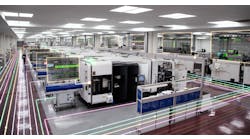Preparedness in CNC programming can result in higher-quality finished parts, less waste, lower costs and faster turnaround times. Prep time is a game-changer in CNC machining. So, what are the benefits of adding it to your production process?
Improve accuracy. Preparedness can maximize the accuracy of CNC programming, resulting in more precise machining. Tasks like refining a CAD design, calibrating machinery, and thoroughly researching stock materials go a long way toward ensuring a smooth process. They also increase the information you have available when programming.
Preparation also will help to ensure you are familiar with all the equipment and materials for your CNC process. This can make programming much faster and easier. It can even help you select the right approach.
For instance, you might realize your part has one machining operation that performs poorly with preset codes. Knowing that, you can manually program a custom operation yourself.
Similarly, proofreading your code in the preparation process lets you mark important commands, leave helpful notes for other machinists, and add stop and restart commands if necessary. All these steps make the machining process easier and ensure maximum accuracy, thanks to clarity and detail in your program.
Maximize tool life. Effective preparation in the CNC programming stage can maximize the performance life of cutting tools. Programming impacts how well a machine can use available tools: Without adequate preparation, clumsy work can increase the risk of tools breaking or experiencing excess wear during machining.
Additionally, conducting plenty of research while developing your CNC program ensures you choose the right tool. Parts that aren't rated for the high pressures of CNC machining will degrade faster and require replacement sooner. Preparation will provide a better understanding of what equipment to choose and the mechanical qualities they need.
Increase machining efficiency. Preparation allows you to streamline your machining process to produce more items in less time. Researching your stock material and mapping out your steps will enable you to hit the ground running when it's time to start work.
Research and planning allow you to make a more informed decision about the type of CNC programming you choose. Manual might be the default option, but it's not always the best fit.
For example, using CAM programming can improve efficiency if you want to create your CNC program directly from a CAD file you already have. It automates the process of converting CAD data into a CNC program, which can save hours of your time. Likewise, conversational programming is a good choice for beginners, or anyone who wants more freedom in their process.
Minimize waste. Research shows industrial processes create 50% of the world's waste, including manufacturing tasks. Allowing time for plenty of preparation can help you minimize the waste you generate in your CNC machining process, which will also save money on stock materials.
Planning, testing, and preparation reduce the likelihood of manufacturing defects – and allow you to refine your process so it uses materials and resources efficiently. For example, you can conduct test runs to minimize the size of each unit of stock material so you create as little waste as possible. Likewise, you can refine your program so your machinery uses energy efficiently.
Lower costs. A well-designed CNC program will machine your items efficiently, maximizing the value you get from the resources that go into each unit. Taking time to prepare and refine your program will pay off in the long run by resulting in a more cost-effective machining process.
This is especially true if you're working with a team with someone else who may use your CNC program. People are less likely to make mistakes when they are clear, detailed, properly formatted and well organized.
CNC Preparation Tips and Tricks
How can you prepare a CNC project before the final machining phase? There are a few essential strategies you can add to your workflow.
Research stock materials, tools. Choosing the right stock material is critical for successful machining. It impacts the programming and design phases, as well. You must thoroughly understand the material you're working with to program your machinery for maximum precision and efficiency.
Spend plenty of time researching potential stock materials and tools. You may even consider getting samples to test. If cost is a concern, remember that less malleable materials require sharper, more durable tools that may be expensive.
Determine process order. Machining processes requiring multiple operations should be mapped out ahead of time. Programming is much more straightforward when you already know everything you need to do. Planning the order also helps prevent costly mistakes.
This step is especially helpful if you are new to CNC programming. Mapping out your machining processes beforehand ensures you remember everything and allows you to concentrate on choosing your CNC codes. You can even match up the appropriate alphanumeric codes on paper before programming your machinery.
Do a test run. A test run is a great idea, particularly if you are machining a large batch of items. It may help to create a checklist of things to verify, such as equipment calibration, tool alignment, tolerances and the steps in your CNC program.
The test run is also a good time to ensure everything is in proper working order. Pay attention to errors, defects, or unusual mechanical behavior. Frequent problems are a common sign of manufacturing inefficiencies and maintenance issues. It's best to catch any potential issues before you start machining a full batch of items.
Prep time is essential for maximizing the quality and value of your machined products or parts. It streamlines the CNC programming process and ensures everything is optimized for low waste and high efficiency. A few easy steps can help you improve your preparedness, including materials research, process mapping and test runs, to ensure high-quality results.
Emily Newton is the Editor-in-Chief of Revolutionized, an online magazine exploring the latest industrial innovations.






